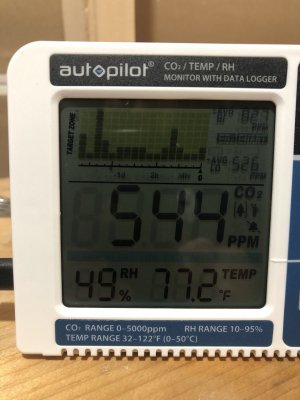So I’ve been monitoring my actual Co2 levels in my fish room. My fish room is 23’x11’x7.5 ceiling.
I’m in Michigan where typically I leave the fish room window cracked most all the time. In Michigan this is the time of year where it starts dipping down below freezing at night. Obviously this makes my energy bill higher and heaters work harder.
What I’ve noticed is even though the fish room isn’t air tight, and has a 6” breather duct going into my attic, how quickly the co2 rises in the room just by me working in there (breathing) with the door shut. Or the furnace running. Typical co2 levels with the windows open in my house are in the low 500 range. With the window closed and me in here it can jump over 650 in less then an hour. When the furnace kicks on 800. Easy. Obviously this directly affects my tanks ph. I also have a gas fire place upstairs, as this is basically prohibited of use, as I can watch the ph litterly drop in my tanks within minutes.
So my question is this. Plants love to absorb co2. Has anyone tried having indoor plants as a method to absorb co2 naturally inside of a house?
I’m in Michigan where typically I leave the fish room window cracked most all the time. In Michigan this is the time of year where it starts dipping down below freezing at night. Obviously this makes my energy bill higher and heaters work harder.
What I’ve noticed is even though the fish room isn’t air tight, and has a 6” breather duct going into my attic, how quickly the co2 rises in the room just by me working in there (breathing) with the door shut. Or the furnace running. Typical co2 levels with the windows open in my house are in the low 500 range. With the window closed and me in here it can jump over 650 in less then an hour. When the furnace kicks on 800. Easy. Obviously this directly affects my tanks ph. I also have a gas fire place upstairs, as this is basically prohibited of use, as I can watch the ph litterly drop in my tanks within minutes.
So my question is this. Plants love to absorb co2. Has anyone tried having indoor plants as a method to absorb co2 naturally inside of a house?



















